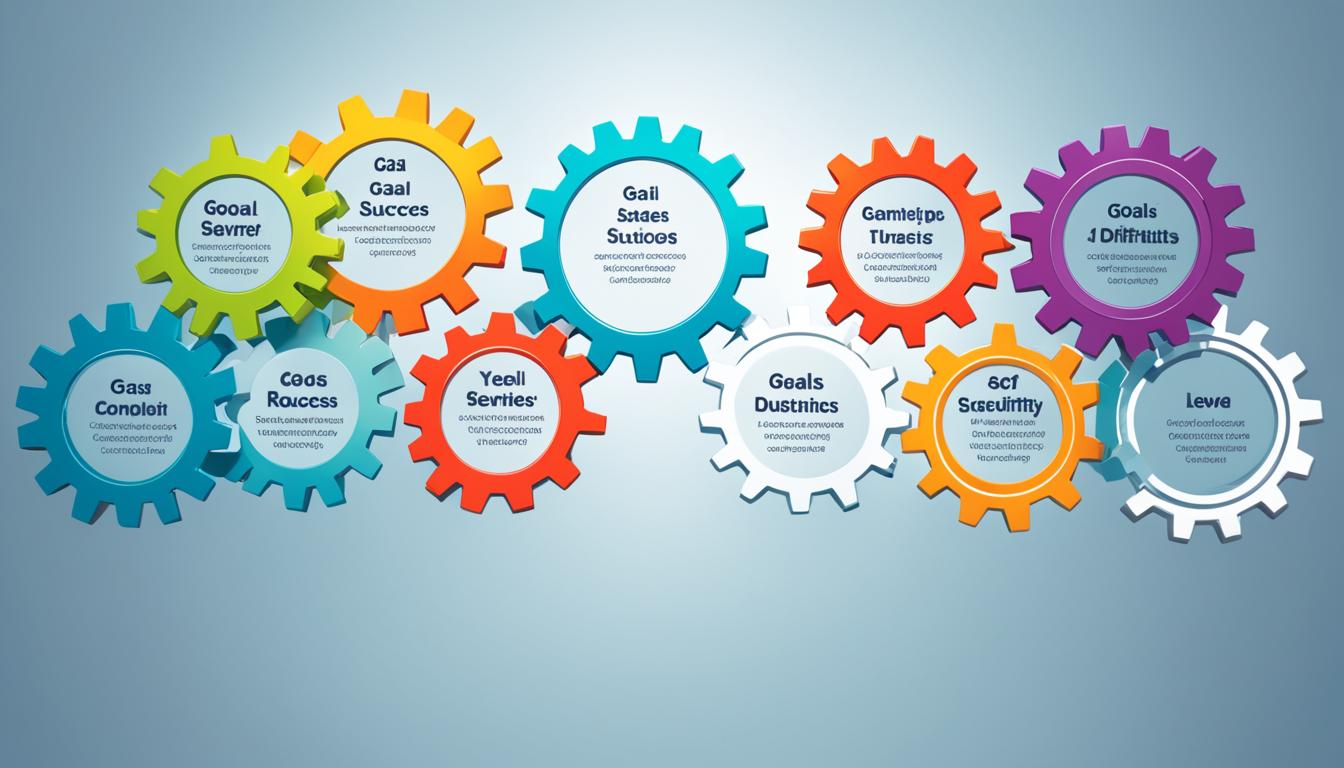Achieve More with Key Goal Setting Statistics

“The future belongs to those who believe in the beauty of their dreams.” – Eleanor Roosevelt
Setting goals is an essential step on the path to success. It allows you to envision your dreams and take meaningful action to make them a reality. But did you know that only a small fraction of people actually achieve their goals? This is where the power of goal setting statistics comes into play.
Understanding the importance of setting goals and the benefits it brings can significantly increase your chances of success. By examining key goal setting statistics, we uncover valuable insights that can help you optimize your goal-setting efforts and achieve more in life.
Are you ready to unlock your potential and turn your dreams into achievements? Let’s dive into the world of goal setting statistics to inspire and motivate you on your journey.
Key Takeaways:
- Setting specific and challenging goals increases the likelihood of success.
- Writing down goals and breaking them into actionable steps improves goal achievement.
- Having an accountability partner enhances motivation and increases goal attainment.
- Visualizing and imagining goals boosts confidence and improves performance.
- Setting realistic and measurable goals is crucial for progress tracking and motivation.
The Power of Goal Setting
Setting goals is a powerful tool that can significantly impact your personal and professional performance. Research suggests that individuals who set goals are 43% more likely to achieve them compared to those who do not. By setting clear and challenging goals, you can propel yourself towards success and achieve better outcomes.
One of the key benefits of goal setting is the ability to track your progress. When you set measurable goals, you can easily monitor your performance and make necessary adjustments along the way. This not only increases your chances of goal attainment but also provides a sense of direction and motivation.
Moreover, goal clarity plays a crucial role in workplace motivation. When you have specific and challenging goals, you are more likely to perform at a higher level, pushing yourself beyond your limits and reaching new heights. These ambitious goals drive your motivation, helping you overcome obstacles and unleash your full potential.
To maximize the effectiveness of goal setting, it is important to set realistic and attainable goals. Setting overly ambitious goals can lead to feelings of discouragement, while setting goals that are too easy may not stimulate enough motivation. Finding the right balance is key to maintaining a positive mindset and staying motivated throughout your journey.

The Science Behind Goal Setting
Numerous studies have been conducted on goal setting, highlighting its effectiveness in various areas of life. Research shows that people who write down their goals are 20% more successful in achieving them compared to those who do not.
Setting actionable tasks for goals and initiating weekly progress reporting to supportive peers can increase goal achievement by 40%. Additionally, goal-setting interventions have been proven to improve academic performance and increase the likelihood of goal attainment.
Studies also suggest that individuals who have a greater understanding of the purpose of their goals are more likely to achieve them. By utilizing goal-setting trends, implementing effective strategies, and considering success factors, individuals can optimize their goal-setting efforts for greater success.
Goal-Setting Trends
Goal-setting trends are constantly evolving, driven by changes in society, technology, and the workplace. To stay ahead of the curve, it is important to be aware of the latest trends and incorporate them into your goal-setting approach.
- Flexible Goal Structures: With the rise of remote work and gig economy, flexible goal structures that adapt to changing circumstances have become increasingly important.
- Outcome-Oriented Goals: Focusing on the desired outcomes rather than specific tasks or actions can help individuals adapt to unexpected challenges and seize new opportunities.
- Emphasis on Well-Being: Setting goals that prioritize personal well-being, such as maintaining work-life balance and taking care of physical and mental health, has gained traction.
By incorporating these trends into your goal-setting practices, you can align your goals with the current demands of the world while maximizing your chances of success.
Effective Goal-Setting Strategies
In addition to staying updated on goal-setting trends, utilizing effective strategies can significantly enhance your goal-setting efforts. Here are some strategies to consider:
- S.M.A.R.T. Goals: Use the S.M.A.R.T. framework (Specific, Measurable, Achievable, Relevant, Time-bound) to create clear and actionable goals.
- Breaking Down Goals: Divide larger goals into smaller, manageable tasks to make progress more tangible and achievable.
- Visualizing Success: Visualization techniques, such as creating vision boards or imagining the successful achievement of goals, can fuel motivation and reinforce commitment.
By implementing these strategies, you can develop a structured and effective approach to goal setting, increasing your chances of success.
Success Factors in Goal Setting
Success in goal setting depends on various factors that can influence the outcome. Understanding and leveraging these factors can greatly enhance the effectiveness of your goal-setting efforts. Some key success factors to consider include:
- Self-Motivation: Enhancing your intrinsic motivation and finding ways to stay engaged and committed to your goals.
- Accountability: Having someone to hold you accountable, whether it’s a mentor, coach, or supportive peer, can significantly increase your chances of goal attainment.
- Continuous Learning: Embracing a growth mindset and seeking opportunities to learn and acquire new skills can bolster your goal achievement.
By incorporating these success factors into your goal-setting approach, you can create a strong foundation for achieving your desired outcomes.

Surprising Goal Setting Statistics
Goal setting statistics reveal interesting insights into the effectiveness of goal setting. According to a survey, visualizing and imagining goals can make individuals twice as confident in achieving them. Setting specific and challenging goals increases the likelihood of success, with 14% of people with goals being 10 times more successful than those without goals. Having an accountability partner increases the chances of goal accomplishment by 65%. Challenging and specific goals have been shown to result in better performance compared to easy goals or no goals. Furthermore, 35% of people fail to accomplish their New Year’s resolutions due to unrealistic goals. Setting high goals has been found to result in better task performance, motivation, and persistence compared to vague goals.

Impact of Goals on Performance
When individuals set specific and challenging goals, it has a profound impact on their performance. By having a clear target in mind, individuals are more likely to stay focused and motivated, leading to increased productivity and success. The act of setting goals helps individuals prioritize tasks, make better decisions, and allocate their time and resources effectively. This, in turn, improves performance and enhances overall outcomes.
| Goal Setting Statistics | Impact |
|---|---|
| Visualizing and imagining goals | Makes individuals twice as confident in achieving them |
| Setting specific and challenging goals | 14% of people with goals are 10 times more successful |
| Having an accountability partner | Increases chances of goal accomplishment by 65% |
| Challenging and specific goals | Result in better performance compared to easy or no goals |
| 35% of people fail to accomplish New Year’s resolutions | Due to unrealistic goals |
| Setting high goals | Results in better task performance, motivation, and persistence |
Conclusion
Goal setting is a proven and essential tool for personal and professional growth. The importance of setting specific, challenging, and measurable goals cannot be overstated. Research consistently shows that individuals who set clear goals are more likely to achieve success.
Writing down your goals and breaking them into actionable steps is a powerful strategy for achieving them. This allows you to stay focused, track your progress, and maintain motivation along the way. Additionally, having an accountability partner can provide the necessary support and encouragement to keep you accountable and on track.
Goal setting statistics demonstrate the undeniable benefits of setting goals. By understanding the science behind goal setting and utilizing effective strategies, such as visualizing your goals and understanding their purpose, you can maximize your chances of success.
Unlock your potential and achieve your desired outcomes by harnessing the power of goal setting. Embrace the challenge, set your goals, and pursue them with determination. The benefits of goal setting are within your reach. Start setting goals today and embark on a journey towards personal and professional growth.






